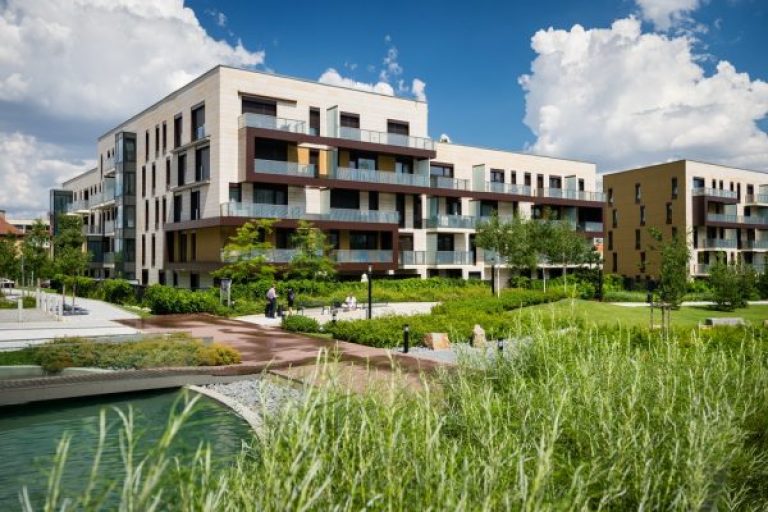Mixed-use in multifamily is going horizontal. Essentially, the horse is now coming before the retail cart, and it’s strolling outward instead of upward.
Panelists at the recent Crittenden conference remarked that horizontal mixed-use developments are here to stay, especially as multifamily housing continues to evolve into a desirable housing choice.
Architects are migrating from vertical mixed-use designs, which they say have recently failed to provide a favorable blend of retail, commercial, and residential Now, the idea is to build around existing retail or establish residences before filling the commercial component. Horizontal designs feature separate commercial centers linked by residences, creating a walkable community near local amenities.
Previously, commercial/retail has suffered as residential communities established themselves, often resulting in unappealing, empty storefronts. The new approach is an effort to strengthen the commercial/retail component, while providing residents with more inclusive neighborhood living.
Some developers are taking it a step farther and including hotel and convention spaces.
“It’s been quite a challenge in the market place in the last 10 years to get retail to fit and work and not have empty storefronts at any one time,” said BGO Architects partner Erik O. Earnshaw, who headed a multifamily design session at the 2016 Crittenden Multifamily Conference in Dallas recently. “The new trend is going to a horizontal mixed-use product. It’s taking retail, restaurants and living and stacking them in a horizontal application.”
First-floor, vertical mixed-use not living up to expectations
The development style supports a more suburban footprint because everything is spread out.
Dallas-based architecture firm Hensley Lamkin Rachel, Inc. has seen a recent shift from more urban core design to horizontal developments in Dallas suburbs Frisco, Plano, Flower Mound and Allen. HLR Founding Principal David W. Hensley said the change is influenced by both changing economic conditions and a willingness of city planners to consider a change after the vertical mixed-use model began failing 10 years ago.
“We’re building multifamily in an environment where commercial already exists,” he said. “The other side of the spectrum is going into areas and rezoning commercial land that’s no longer viable and getting multifamily to add rooftops to a commercial district.”
In recent years, and much to the urging of city planners, HLR designed properties in the walkable Uptown area of Dallas and incorporated the first-floor retail concept.
“They acknowledged that the old model where multifamily simply put retail in the bottom, where it wasn’t designed for retail but designed for multifamily, they could see it didn’t work,” Hensley said.
Easy connectivity promotes commercial/retail
Today, HLR and others are finding success in sprawling developments that have perhaps the biggest amenity of all – easy connection to a thriving community.
At Crittenden, Addison, Texas-based BGO Architects showed the master plan of a Central Texas mixed-use development next to an existing river park. Apartments and townhomes will flank a separate retail center at the front and a hotel/conference center in the middle. The retail element will include boutique-style shopping, restaurants, and office space.
In addition, a large outdoor gathering area will be surrounded by trees, water features, historical vignettes and an art installation. The river park will eventually be developed to include a hillside amphitheater, fountains, and a children’s playground.
To connect the development, a walkway system will be built and the boulevard-style entrance will blend into the interior road system. Earnshaw said close proximity to the river park, plus the inclusive development design, will provide the kind of desirable living spaces and connectivity that multifamily dwellers seek today.
“The interconnection and outdoor activity is what all residents are looking for, and how the community ties into a greater-sized atmosphere,” he said.
‘It’s rooftops that help drive the retail’
Hensley said horizontal mixed-use developments – among them are popular town centers – work well when multifamily is established and retail is added later, despite what others may think.
In one Dallas/Fort Worth suburb, HLR successfully pleaded its case to build apartments first and hold off on the retail. Units were completed in 2011 and the first retail installation arrived two years later. By then, there were enough residents and others from surrounding neighborhoods to support new businesses.
“It’s rooftops that help drive the retail, otherwise the retail doesn’t work,” Hensley said.
HLR completed a successful horizontal mixed-use development in Flower Mound, a suburb north of DFW International Airport.
Lakeside DFW is a master-planned community with multifamily and single family residential and commercial overlooking Lake Grapevine. The development is a city within a city, complete with a 26-acre retail center and amenities like an amphitheater, town-square park and the 3.5-mile Lakeside Trail.
A movie house and eatery opened in July 2015, and an $80 million, 12-story hotel located on the development’s southern 25-acre peninsula was recently announced. BNSF Logistics’ global headquarters anchors Lakeside’s business district.
Accessible by a walking path, the nearby apartment community features one and two bedroom units and lofts on 21-acres and connects a regional trail system. Pocket parks, an esplanade and splash-park promote outdoor activities just a short distance away.
Not all are ground-up developments like Lakeside DFW, either.
“We’re seeing more and more of these communities where they are allowing us to do a component of multifamily in a larger community that includes retail,” he said. “They all want white-table-cloth restaurants, which isn’t always feasible. We’re doing a few multifamily mixed-use developments with office buildings, we’re doing a lot combined with small retail.”
Not your parents’ multifamily anymore
City planners, Hensley said, are shedding preconceptions that apartments only look good for a few years and are prone to dilapidation. Instead, they are the places to be and not born of necessity, especially when enhanced by easy connection to parks, trails and thriving shopping and urban hotspots.
“I think part of this walkable community is selling that story that it’s not your parents’ multifamily,” Hensley said. “It’s by choice.”
Horizontal mixed-use is another example how multifamily is adapting to a changing landscape. It’s a whole new generation of apartment living.

